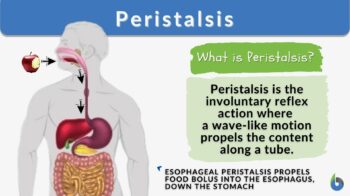
Peristalsis
n., plural: peristalses
[ˌpɛɹɪˈstɑlsɪs]
Definition: Rhythmic contraction and relaxation of muscles resulting in the propulsion of the contents along a tube
Table of Contents
What is Peristalsis?
Peristalsis is the series of involuntary, wave-like muscle movements in the cylindrical, hollow tube of the body. Most commonly, in humans, peristalsis occurs in the gastrointestinal (GI) tract to propel the content of the GI tract from the pharynx to the anus. In peristalsis, longitudinal muscle and circular muscles symmetrically contract and relax to propel their content through it.
Peristalsis is a normal physiological process that can be seen in the human body in different parts of the body/organ for the movement of content as…
- In the GI tract for the movement of food essential for the digestive process via the digestive system
- In the gall bladder to send the bile to the duodenum
- In the kidney transferring the urine to the urinary bladder
In the GI tract, a strong wave of peristalsis is induced in the esophagus upon the entry of food or liquid. The content is then propelled towards the stomach wherein due to peristaltic movement it churns up with the liquid present and forms chyme. The chyme is then propelled towards the small intestine and later to the large intestine and eventually expelled from the body via the anus.
Peristalsis is an involuntary reflex action wherein a wave-like motion is generated in the lumen of the hollow tubular organ like the gastrointestinal tract, to propel its content forward. Peristalsis is a normal process required for the movement of food in the GI tract, transfer of urine from the kidney to the urinary bladder, and movement of bile from the gall bladder to the duodenum.Etymology: Greek ‘stalsis’, meaning “contraction”.
Peristalsis is a reflex action wherein, the entry of food or liquid in the pharynx induces peristalsis in GI muscles, which is also referred to as ‘primary peristalsis’. Further, peristalsis movement induced due to esophageal distention is referred to as ‘secondary peristalsis’.
- Peristaltic waves propel the GI content toward the anus is called antegrade peristalsis. The wave-like peristaltic movement in the GI tract ensures not only the propulsion of the GI content but also causes the mixing of the chyme and the absorption of nutrients through the walls of the tract.
- A peristaltic wave that propels the GI contents in a reverse direction, i.e., toward the oral cavity or mouth is known as retrograde peristalsis. Retrograde Peristalsis is also referred to as reverse peristalsis and is responsible for vomiting. In retrograde peristaltic movement, the content of the lumen moves from the intestine towards the esophagus which can eventually result in vomiting. Generally, irritation of the stomach lining and poisoning (food or drug) stimulate the emetic center (or chemoreceptor trigger zone, CTZ) in the brain that induces the vomiting reflex to eliminate the causative agent from the body.
NOTE IT!
“Peristalsis vs. Segmentation”
Peristalsis is a smooth muscle contraction movement that occurs throughout the GI tract and functions to propel the food through the GI tract in one direction only. In contrast, Segmentation is another involuntary smooth muscle contraction that occurs only in the intestine. In segmentation, the contraction occurs back and forth and it functions not only to move the food but also to mix up and break the content and expose its surface for nutrient absorption as well. (Figure 1)
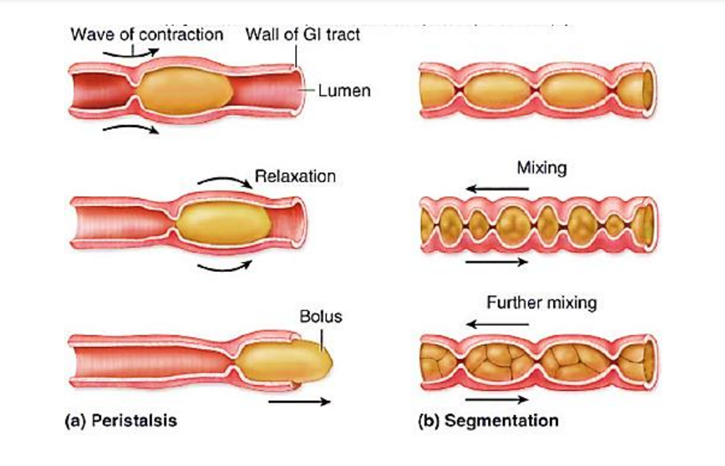
Human Physiology
Polarisation of the myenteric plexus is responsible for the antegrade peristalsis, i.e., from the esophagus towards the anus. Due to this, peristalsis is often referred to as myenteric reflex. The myenteric plexus is stimulated by the parasympathetic nervous system.
Mechanism of the peristaltic reflex
Upon the arrival of content (food/liquid), two major reflexes in the enteric nervous system induce the peristalsis movement in the lumen. The two reflexes are mechanical distention of the lumen and mucosal irritation that stimulate the afferent enteric nerves of the enteric nervous system. Cholinergic interneurons synapse with these two sensory neurons leading to the following effects:
» One of the interneurons stimulates the excitatory motor neurons by releasing acetylcholine and substance P. These motor neurons are located above the bolus and their stimulation leads to peristaltic contractions of smooth muscles.
» The other interneurons release neurotransmitters like nitric oxide, vasoactive intestinal peptide, and ATP, to stimulate the inhibitory neurons that are located below the bolus. This results in the relaxation of smooth muscle below the bolus.
In summary, one set of smooth muscles contracts while the other set of muscles relaxes.
During peristalsis, the muscles that contract are the longitudinal muscles that are present in the luminal segment ahead of the progressing luminal contents. While the muscle layer which relaxes is the circumferentially oriented muscles present in the same segment.
As a result of this simultaneously, the longitudinal axis of the luminal cylinder is shortened while the cross-sectional diameter widens which causes the extension of the lumen.
Thus, the receiving segment of the lumen prepares itself for the progressing intraluminal contents during peristalsis. (Figure 2)

Esophagus
Swallowing of the food induces the primary peristalsis wave in the esophagus. The primary peristaltic wave functions to send all the food to the stomach (Figure 3). A secondary peristalsis wave is also stimulated around the bolus in the esophageal lining to ensure the complete transfer of food to the stomach (Figure 4).
This peristalsis is also referred to as esophageal peristalsis. Esophageal peristalsis occurs unidirectionally i.e., from mouth to stomach, and generally, two or three waves are stimulated simultaneously.
The duration of the primary wave is around 8 to 10 sec whereas the subsequent secondary peristalsis wave continues indefinitely until the food reaches the stomach. Once the food reaches the stomach, the esophageal peristalsis is inhibited.
Even the fat present in the food tends to inhibit esophageal peristalsis. Also, the dilution of food with gastric juice inhibits or reduces the peristalsis wave. The swallowing center present in the medulla oblongata and lower pons controls the primary peristalsis and post vagotomy, this becomes non-functional. On the other hand, the secondary peristalsis wave is controlled by the efferent nervous system and remains unaffected by vagotomy.
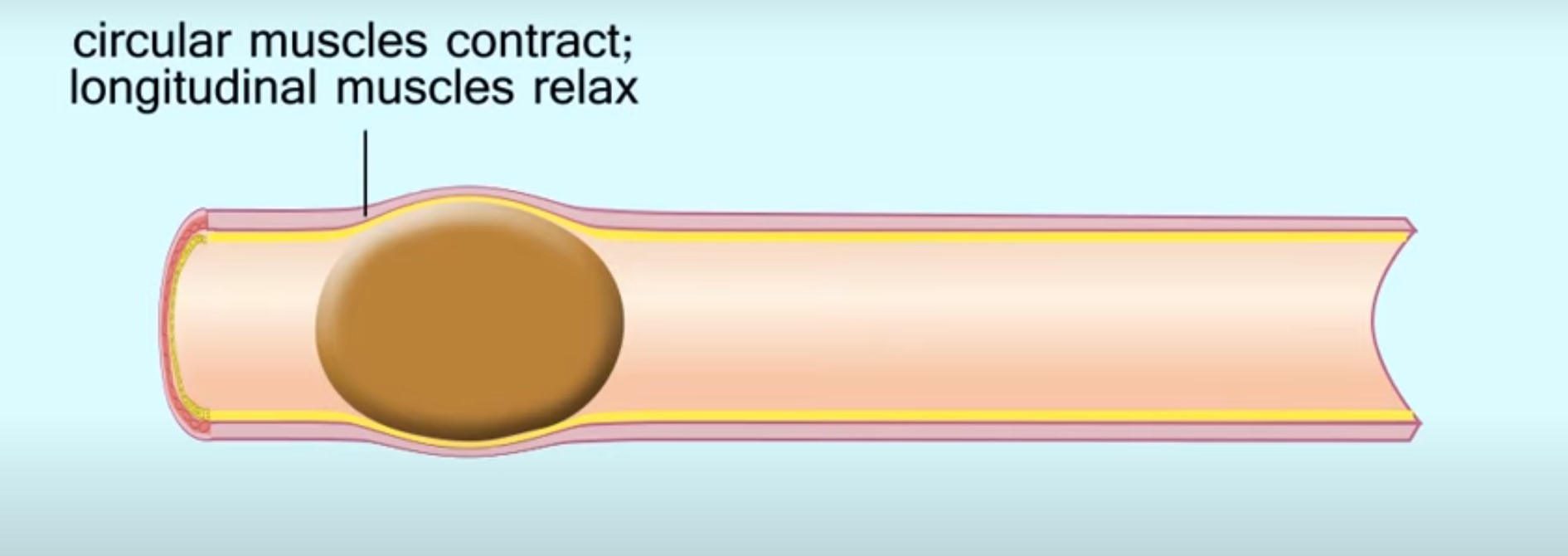 |  |
| Figure 3: Primary peristaltic wave. Image from the tutorial video of ben Sir. (Watch the video below) | |
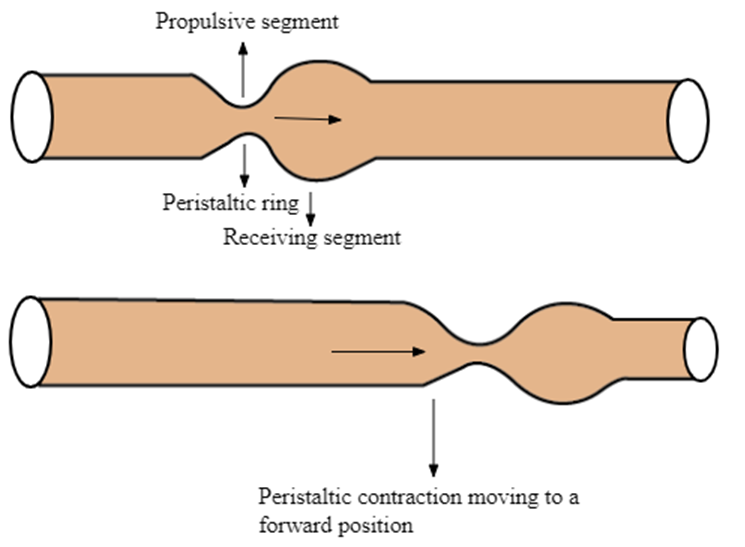
A third type of esophageal peristalsis, i.e., tertiary peristalsis wave also occurs. This is usually seen in the elderly and is associated with motility disorder resulting in impaired acid clearance. These waves are dysfunctional, isolated, and irregular contractions in the oesophageal wall. Corkscrew esophagus patients usually exhibit such peristalsis waves and cause achalasia esophagus along with diffuse spasm in the esophagus.
Stomach
The gastroesophageal sphincter or the cardiac sphincter of the stomach opens up upon the arrival of the peristalsis wave, thus allowing the passage of food bolus to the stomach from the esophagus. The gastroesophageal sphincter acts as a guard and does not allow the food to return to the esophagus. The thick muscular layers of the stomach move which results in the mixing of the food content with the gastric juices resulting in the formation of chyme. The thickest layer of the stomach, the muscularis layer, exhibits maximum peristalsis movement. The pyloric sphincter present at the distal end of the stomach (where the stomach joins the intestine) regularly opens up to transfer the food from the stomach to the intestine. (Figure 5)
Small intestine
Once the chyme enters the small intestine from the stomach, the peristalsis wave fades away in a few seconds. Further, the chyme moves at a very slow pace, ~few mm/sec, in the small intestine as the small intestine is the primary site for the absorption of nutrients from the food. Hence, the slow movement of food through the small intestine ensures that sufficient time is there for the maximum absorption of nutrients from the food. The length and duration of peristalsis wave in the small intestine is irregular and it functions to expose the surface of the chyme for nutrient absorption. (Figure 5)
Large intestine
Peristalsis waves are also seen in the large intestine and are referred to as mass movement. These peristalsis waves are progressive and continuous that occur 4 to 5 times a day to propel the chyme/food content forward in the large intestine. Least peristalsis waves are seen in the rectum.
The digested food eventually is pushed or propelled toward the rectum for its removal from the body. The strong peristalsis wave forces the digested food towards the rectum, along with the surge of desire to defecate to remove the content from the anus. In case the feces are not eliminated from the anus, it comes back to the small intestine due to reveres peristalsis wave. Removal of gases and undesirable bacterial colonies from the intestine also occurs due to peristalsis waves.
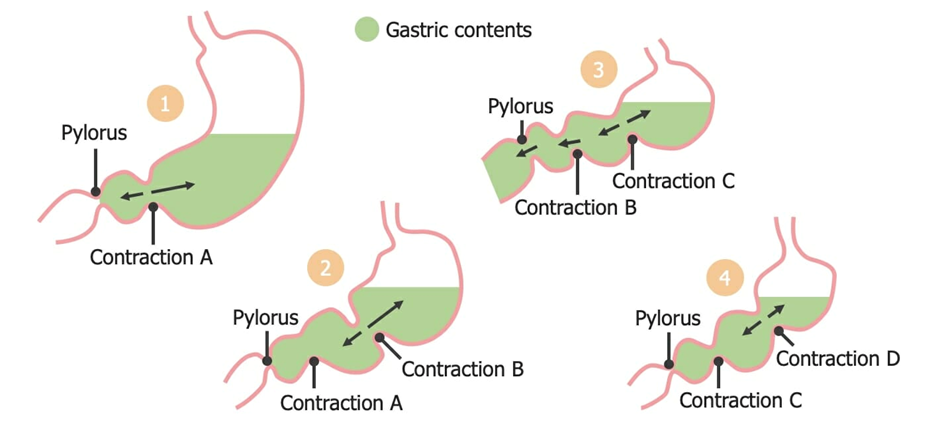
Lymph
Unlike the circulatory system that pumps blood throughout the body, the lymphatic circulation in the body does not have any pump and the movement of lymph in the body occurs due to peristalsis movement in the lymphatic vessels.
Sperm
During ejaculation, the propulsion of sperm from the testicles to the urethra occurs due to the generation of peristalsis waves in the walls of smooth muscles of the vas deferens.
Earthworms
Earthworms are limbless annelid, have a hydrostatic skeleton, and move through peristalsis. The hydroskeleton of earthworms has an extensible body wall that surrounds a central fluid-filled cavity. While moving, the anterior portion of the earthworm constricts radially which pulls the body backward or posteriorly while the hydrostatic pressure increases the length of the body.
The earthworm is a segmented worm and in each segment, alternate muscle contractions of longitudinal and circular muscle occur. Thus, each segment of the body moves forward, then relax and reconnects with the surface with the help of special structures known as setae.
Setae are small bristles that act like an anchor and help the worm to avoid slipping. Some other invertebrates like millipedes and caterpillars also move through peristalsis. Snails and leeches also move by peristalsis movement. (Figure 6)

Conditions and Disorders
Let’s find out the different conditions and disorders related to peristalsis.
What are the symptoms of peristalsis problems?
GI motility disorders are due to the peristalsis problem. Since the peristalsis is involved in the movement of food through the GI tract, a problem in peristalsis will either cause the movement of food too slow (constipation) or too fast (diarrhea). In the case of diarrhea, the food moves too fast in the GI tract without getting properly digested and nutrient absorption. While in constipation, there is reduced GI motility, i.e., hypoperistalsis or hypomotility. This results in the accumulation of digested food and bacteria in the body leading to bacterial overgrowth and constipation.
GI symptoms like bloating, abdominal gas, flatulence, diarrhea, constipation, nausea, acid reflux, abdominal pain, nutritional deficiency, and dysphagia are commonly seen when there is a peristalsis problem.
Absent peristalsis or paralytic ileus is the condition when a peristalsis wave is not generated even when the stimulus is present.
What causes problems with peristalsis?
Peristalsis phenomena are controlled by a complex combination and coordination between muscles, nerves, and hormones. Problems in peristalsis may occur due to infection, drugs, disease conditions, hormonal imbalance, electrolyte imbalance, and injury. Drugs like calcium channel blockers, anticholinergics, tricyclic antidepressants, and opioid pain relievers may cause GI motility disorders. Disease conditions like diabetes, thyroid, any surgery, scleroderma, and inflammation also exhibit GI motility problems.
Take the Peristalsis – Biology Quiz!
Further Reading
- Biology Tutorial – Digestion and Absorption of Food
- Digestive Enzymes – Biology Online Archive Article
References
- Goyal, R. K., & Chaudhury, A. (2008). Physiology of normal esophageal motility. Journal of clinical gastroenterology, 42(5), 610–619. https://doi.org/10.1097/MCG.0b013e31816b444d
- Huizinga, J. D., & Lammers, W. J. (2009). Gut peristalsis is governed by a multitude of cooperating mechanisms. American journal of physiology. Gastrointestinal and liver physiology, 296(1), G1–G8. https://doi.org/10.1152/ajpgi.90380.2008
- Mittal R. K. (2016). Regulation and dysregulation of esophageal peristalsis by the integrated function of circular and longitudinal muscle layers in health and disease. American journal of physiology. Gastrointestinal and liver physiology, 311(3), G431–G443. https://doi.org/10.1152/ajpgi.00182.2016
- Patel, K. S., & Thavamani, A. (2023). Physiology, Peristalsis. In StatPearls. StatPearls Publishing.
©BiologyOnline.com. Content provided and moderated by Biology Online Editors.


